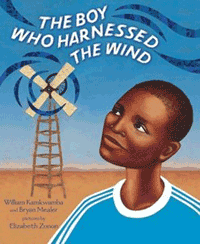By William Kamkwamba & Bryan Mealer
Illustrated by Elizabeth Zunon
Dial, 2012
$16.99, ages 6 and up, 32 pages
It stood like a clumsy giraffe and was cobbled from metal scraps, but to a teen named William it was more magical than anything he'd dreamed.
In this inspiring adaptation, Africa's William Kamkwambi recounts with New York author Bryan Mealer how he rigged a windmill for his poor village using only a picture as his guide.
The story, which can be read for free online at wegivebooks.org, is based on Kamkwamba's New York Times best-selling memoir by the same name, also co-authored by Mealer.
The story, which can be read for free online at wegivebooks.org, is based on Kamkwamba's New York Times best-selling memoir by the same name, also co-authored by Mealer.
Kamkwamba and Mealer condense the story beautifully, while West Africa-born artist Elizabeth Zunon conveys Kamkwamba's irrepressible spirit with fluid cut-outs and luminous, earthy oil paintings.
At age 14, William Kamkwamba pondered the possibilities of what could be. When night came to his drought-ravaged village of Malawi, he closed his eyes to see where his mind would take him.
In his dreams he built things and took them apart, like trucks with bottle-cap wheels and pieces of radio, and he wondered things. "If I can hear the music, then where is the band?"
He also dreamt of his grandpa's tales of witch planes and ghost dancers, hovering and twirling "as if a hundred men were inside their bodies."
At dawn, as he threw his hoe in the fields, his mind also wandered. He imagined magical beings drifting in the maize rows and wondered what made the engine of a passing truck go.
But as drought took hold and turned the maize to dust, William and his family, along with other villagers, found themselves in desperate need.
Blog: Where The Best Books Are! (Login to Add to MyJacketFlap)
JacketFlap tags: 2011, Earth Day books, Energy Island, a children's story about Samso, Allan Drummond, pinwheels to turbines, children's books about wind power, Add a tag
How One Community Harnessed the Wind and Changed their World
Written and illustrated by Allan Drummond
Frances Foster Books, 2011
$16.99, ages 6-10, 40 pages
A Danish island where hats are always flying off heads learns to harness the energy of the wind and takes itself off the grid.
In this remarkable true story, Drummond tells about the people of Samso who used the very thing they couldn't escape from -- buffeting winds -- to work for them.
In 1997, Denmark's government designated the island as its "renewable energy island" -- a region that could eventually run completely on free, nonpolluting energy thanks in a large part to its windy location.
Since then, the island off the coast of Denmark has become almost entirely energy independent through the use of wind turbines, as well as district heating plants, biomass and solar panels.
It's even able to export surplus electricity from those turbines to the mainland and it has eliminated its carbon emissions by 140 percent.
That means if you were to look for a carbon footprint there, you wouldn't find one.
But becoming a green island was quick and it wasn't easy.
This is a story about ordinary people who, at first, weren't so sure they wanted to fuss with clean energy.
They didn't think about where their energy came from and they weren't very motivated to conserve it:
They switched on lots of lights, turned up heaters too much, used hot water without thinking, and expected oil to arrive by tanker ships or trucks and their electricity through cables.
Sound familiar? That's partly what makes this story remarkable -- they were people very much like everyone else.
Then one day, the Danish Ministry of Environment and Energy planted the idea that Samso could be more than a fossil fuel consumer.




